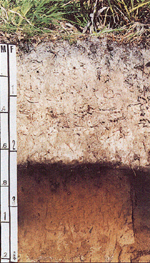
Photo from wikipedia
Models used to assess leaching risks generally use organic carbon partition coefficient (kOC ) values derived from batch experiments on topsoil samples to estimate pesticide sorption in subsoils of much… Click to show full abstract
Models used to assess leaching risks generally use organic carbon partition coefficient (kOC ) values derived from batch experiments on topsoil samples to estimate pesticide sorption in subsoils of much smaller organic carbon contents. This can introduce significant errors in leaching risk calculations, because inorganic sorbents can play an important role for sorption in subsoil. The objectives of the present study were therefore to summarize the available literature data on pesticide sorption in subsoils and to test whether a simple alternative model could improve on the standard kOC approach used in risk assessment models for pesticide leaching. This model describes the sorption constant as a power law function of the organic carbon content. A database with the results of batch sorption experiments was collated from published studies that emphasized measurements in subsoils. This database contains 1029 data entries from 36 published studies with data for 29 active substances (11 nonionic compounds, 10 weak acids, 6 weak bases, one cation, and one zwitterion). The results show that whereas the constant kOC model proved to be an adequate model for 17 of the 63 individual datasets, the power law model gave acceptable fits (p < 0.05) for 60 of these cases. The exponent in the power law model varied over a wide range, from slightly negative to near unity. It also differed significantly (p = 0.015) for ionized and nonionized compounds, with median values of 0.25 and 0.55, respectively. It is concluded that the power law model could be used to parameterize subsoil sorption in regulatory leaching models, because it has widespread applicability and is simple enough for this purpose. Suitable ways of incorporating this approach in risk assessment procedures are discussed. Environ Toxicol Chem 2018;37:755-761. © 2017 SETAC.
Journal Title: Environmental toxicology and chemistry
Year Published: 2018
Link to full text (if available)
Share on Social Media: Sign Up to like & get
recommendations!